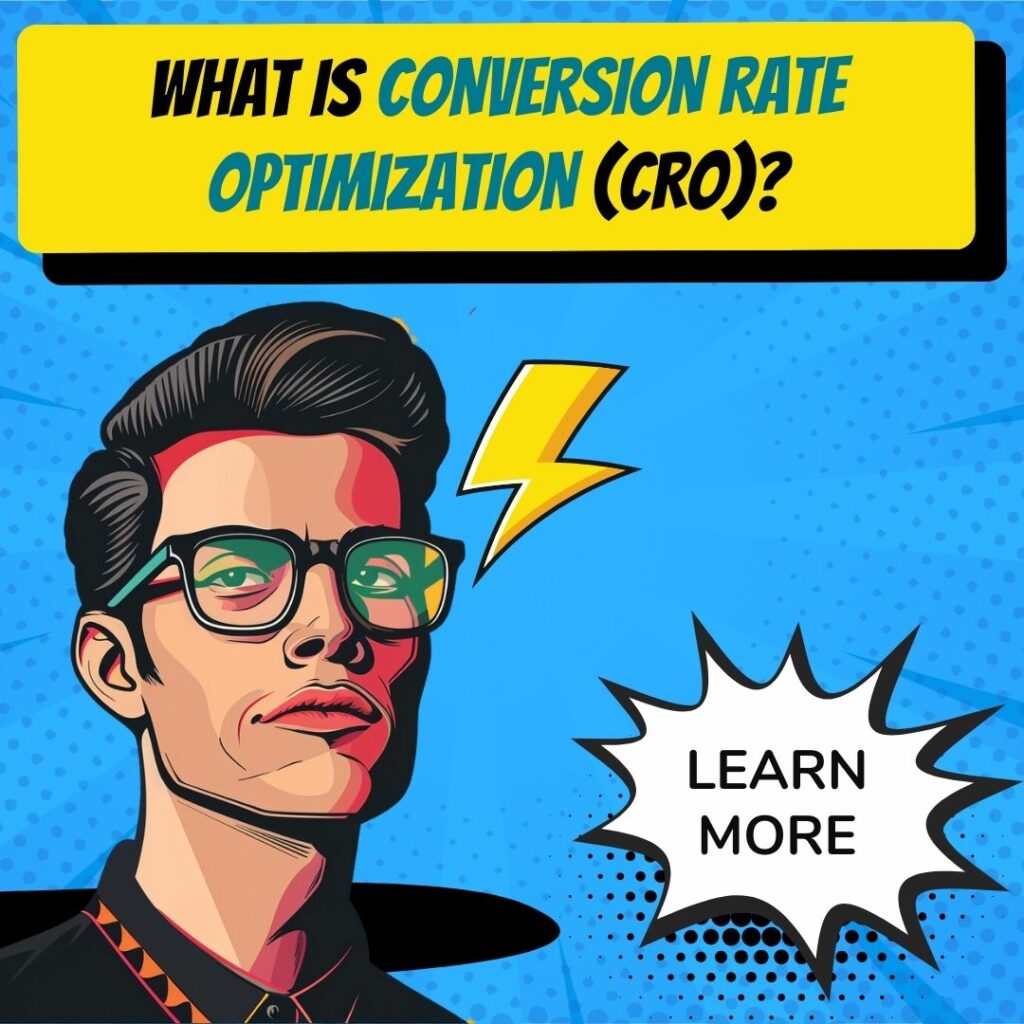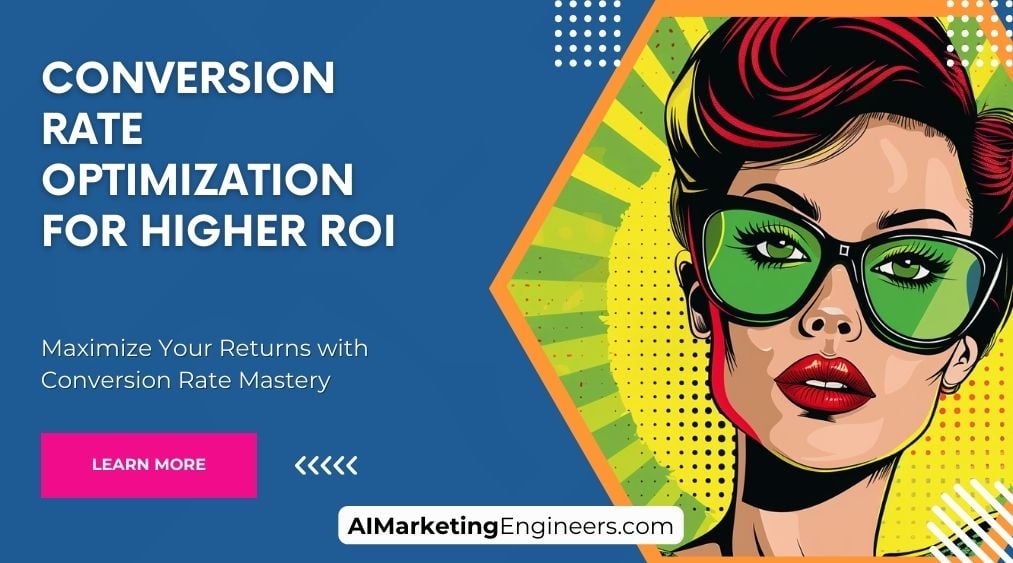Key Takeaways
✅ Revamp the Journey: Optimize user experience by tailoring your site’s design and layout to meet customer expectations, enhancing engagement and driving conversions.
✅ Test. Learn. Repeat: Embrace continuous A/B testing to iterate and refine your strategies, staying data-informed for progressive enhancements.
✅ Personal Touch: Unlock new heights in your conversion rates by offering personalized content and recommendations, ensuring each customer’s journey is as unique as they are.

Introduction
Are you capturing the value every visitor brings to your digital doorstep? In the realm of e-commerce, the golden thread to prosperity is woven with the finesse of Conversion Rate Optimization (CRO). This all-star player is the gatekeeper to amplifying your Return On Investment (ROI), turning browsers into buyers, and clicks into cash registers singing.
This provocative journey through CRO isn’t just a litany of best practices; it’s your front-row ticket to a performance where data meets design and psychology courts technology. Transforming User Experience and mastering Behavioral Analytics are no longer the future—they’re the now. And it’s not just about keeping up; it’s about leading the charge.
We’ll dive deep beyond the surface, surfing the waves of Competitor Analysis, strategizing with A/B Testing, and elevating the art of Persuasive Copywriting. Rest assured, this is not just another article—it’s a blueprint for success. Prepare to embark on an exhilarating ride that will equip you with groundbreaking insights and actionable strategies to not just nudge the needle but to make it leap forward. Welcome to the conversion revolution. Are you ready to Maximize Your ROI?
Top Statistics
| Statistic | Insight |
|---|---|
| Global CRO Market Size: Valued at $354 million in 2020 with a CAGR of 8.6% from 2021 to 2028. (Source: Grand View Research) | This growth showcases the expanding emphasis on optimization strategies tailored to complement the dynamic e-commerce landscape, revealing a field ripe with opportunities. |
| Increasing Investment in CRO: 70% of companies plan to intensify their investment in 2021. (Source: Econsultancy) | This indicates a majority stakeholder consensus on the pivotal role of CRO in securing a formidable market position and carving a path for sustainable growth. |
| Industry Adoption: 57% of companies have a dedicated team for CRO. (Source: Smart Insights) | The presence of specialized teams underlines the complexity and significance of CRO as a standalone discipline in the digital marketing spectrum. |
| Mobile Optimization: Mobile conversion rates are 2.2 times lower than desktop. (Source: Think with Google) | This statistic is a call to action for businesses to address mobile-specific barriers and refine UX to capitalize on the considerable mobile traffic. |
| Page Load Speed: A one-second delay reduces conversions by up to 7%. (Source: Think with Google) | A vital reminder that usability factors such as page load speed can have a significant impact on profitability and should be a critical element in any CRO strategy. |
Understanding Your Audience
The foundation of effective CRO lies in understanding your target audience. Conduct thorough user research to identify their pain points, preferences, and behaviors. Analyze how they navigate your website, where they get stuck, and what motivates them to take action. Create detailed buyer personas to guide your optimization efforts and ensure you're speaking their language.
Optimizing the Customer Journey
1. Website Design and User Experience
Your website is the digital storefront for your business, and first impressions count. Ensure a clean, intuitive, and mobile-friendly design that seamlessly guides visitors through the sales funnel. Improve navigation and information architecture to make it easy for users to find what they're looking for.
2. Calls-to-Action (CTAs)
Strategically placed, compelling CTAs are the backbone of conversion optimization. Experiment with different CTA copy, colors, and placements to see what resonates best with your audience. Your goal is to create a sense of urgency and encourage visitors to take the next step in their journey.
3. Landing Page Optimization
Crafting high-converting landing pages for specific marketing campaigns is essential. Eliminate distractions and focus on a single conversion goal. Continuously test and refine the page elements, from the headline to the form, to find the winning formula.
4. Form Optimization
Streamline and simplify your forms to reduce friction and make it easy for customers to share their information. Test the number of form fields, their placement, and the copy to provide a user-friendly experience.
5. Checkout Process Optimization
The checkout process is a critical stage in the customer journey. Optimize the flow to minimize abandonment, implement secure and user-friendly payment options, and provide clear progress indicators to reduce cognitive load.
Leveraging Data and Analytics
Implement robust tracking and measurement tools to gather insights into user behavior and conversion data. Leverage A/B and multivariate testing to identify the strategies that resonate best with your audience.
Continuous Improvement and Iteration
Adopt a data-driven, iterative approach to CRO. Continuously test and refine your optimization efforts, celebrating quick wins and learning from failures. Remember, conversion rate optimization is an ongoing process, not a one-time project.
Inspirational Quotes
1. “Conversion rate optimization is not about tweaking pages; it’s about understanding your users and how they interact with your website.” – Peep Laja
Peep Laja, a renowned figure in the digital marketing world, succinctly captures the essence of Conversion Rate Optimization (CRO). It’s a potent reminder that behind every click, there’s a person whose needs and experiences shape the success of our digital storefronts. By observing and empathizing with their journey, we unlock the blueprint to more meaningful interactions and, ultimately, better conversion rates.
2. “The secret to high-converting landing pages isn’t just about colors or fonts. It’s about relevancy, clarity, and empathy.” – Oli Gardner
Diving much deeper than aesthetic choices, Oli Gardner brings to light the true ingredients of powerful landing pages. He encourages us to step into our users’ shoes, identify with their quest for value, and provide answers with utmost clarity. By doing so, we forge a connection that resonates, elevates user experience, and transforms visitors into loyal customers.
3. “A small improvement in your conversion rate can have a dramatic impact on your profitability over time. Small improvements accumulate and result in massive growth.” – Neil Patel
In the quest for massive growth, Neil Patel reminds us that the journey begins with a single step. It’s the aggregation of marginal gains that builds empires. The evolution of our e-commerce strategy doesn’t demand leaps and bounds—rather, a continuous commitment to incremental progress. In doing so, we set the stage for sustained growth and enduring success.
AI Marketing Engineers Recommendation
Recommendation 1: Leverage Artificial Intelligence for Personalization: Utilize AI-driven tools to personalize the customer experience meticulously. Segment your audience based on their behavior, interests, and purchase history, then deploy personalized content, product recommendations, and offers. Stats show personalized CTAs convert 202% better than default versions. Advanced AI can track user behavior in real time, allowing for dynamic personalization that adapts to customer interactions. Personalization not only increases conversion but also boosts customer loyalty, resulting in higher lifetime value.
Recommendation 2: Optimize for Mobile-First Experiences: With mobile commerce expected to control 72.9% of the e-commerce market by 2021, designing mobile-first experiences is non-negotiable. This strategic approach ensures the customer journey on mobile devices is seamless and engaging, which is crucial as Google’s Mobile-First Indexing now prioritizes mobile-friendly websites. Implement responsive design, optimize checkout processes with digital wallets, and ensure your pages load quickly (under 3 seconds) to reduce bounce rates and convert mobile traffic effectively.
Recommendation 3: Adopt Conversion-Focused Analytics Platforms: Integrate tools like Hotjar or Crazy Egg that provide heatmaps, scroll maps, and click tracking to gain insights into user interaction patterns on your site. Analyze customer journeys to identify friction points that could be causing drop-offs and test solutions using A/B split testing. Optimizing the flow on your website based on this data directly addresses user experience issues, thereby potentially increasing your conversion rate significantly. These platforms often also offer visitor recordings, giving a ‘behind-the-screen’ look at your customers’ browsing habits, which is invaluable for ongoing optimization tactics.
Conclusion
As we draw the curtains on this deep dive into Conversion Rate Optimization, it’s clear that CRO is far more than a mere buzzword; it’s an essential pillar in crafting a successful, ROI-driven e-commerce strategy. Maximizing Your ROI with Conversion Rate Optimization doesn’t stop at just understanding what actions users take on your site; it’s about immersing yourself in their journey, predicting their needs, and smoothing the path to conversion.
Every touchpoint, from intuitive design and strategic copywriting to psychological nudges and performance analytics, should harmonize to elevate user experience and, ultimately, enhance your bottom line. Remember, analyzing user behavior is not a one-and-done deal—it’s an ongoing conversation with your audience, a continuous loop of hypothesis, testing, learning, and refining.
The insights from your competitor analysis, the clarity drawn from your A/B tests, and those micro-moments of delight created by impeccable UX design, all converge to spike your conversion rates and multiply that ever-sought-after ROI. It’s not about re-inventing the wheel, but rather greasing it to roll smoother, faster, and with purpose. Empower your virtual shopfront with these insights and witness the transformation in your engagement metrics. Stay patient, stay data-informed, and most importantly, stay attuned to the shifting digital landscapes and user preferences.
The e-commerce arena is a thrilling, dynamic sphere—the more responsive and adaptable you are, the better your chances of securing a robust ROI. So, leverage your newfound knowledge, roll out your optimization strategies, and continue to seek out the latest innovations in CRO practices to stay ahead. Your journey to higher returns and optimized user interactions is well within reach, and every click, every swipe, every satisfied customer is a step in the right direction. Now, go forth and optimize!
FAQs
Question 1: What is Conversion Rate Optimization (CRO)?
Answer: CRO refers to the process of increasing the percentage of website visitors who complete desired actions such as making a purchase, filling out forms, or subscribing to newsletters. It involves analyzing user behavior, testing different elements, and optimizing web pages to improve overall conversion rates.
Question 2: Why is CRO important for higher ROI?
Answer: By improving your conversion rate, you can generate more revenue from existing traffic without spending additional money on advertising or marketing efforts. This leads to better returns on investment (ROI), as every dollar spent on acquiring new customers becomes more profitable.
Question 3: How do I identify areas for improvement in my website’s conversion rate?
Answer: Start by analyzing website data using tools like Google Analytics to understand how users interact with your site. Identify high-traffic but low-converting pages, look at bounce rates, time on page, and other engagement metrics to pinpoint potential issues. User feedback surveys and heatmap analysis are also helpful in understanding user behavior and identifying areas for optimization.
Question 4: What are some common techniques used in CRO?
Answer: A/B testing, multivariate testing, personalization, and UX design improvements are among the top techniques used in CRO. These methods involve experimenting with different variations of pages, CTAs, copy, images, and layouts to find the best performing combination. Personalization tailors experiences to individual user needs, while UX improvements focus on enhancing usability, accessibility, and visual appeal.
Question 5: Should I prioritize mobile or desktop conversions first?
Answer: Prioritize mobile optimization since an increasing number of users access websites via mobile devices. Ensure your site is responsive, loads quickly, and provides a seamless user experience on mobile devices.
Question 6: How can I measure the success of my CRO efforts?
Answer: Track key performance indicators (KPIs) such as conversion rate, bounce rate, average order value, and time on page to gauge the effectiveness of your CRO efforts. Compare results before and after implementing changes to understand how your optimization efforts impact overall performance.
Question 7: How do I balance CRO and user experience?
Answer: Focus on improving the user experience as a means to increase conversions. Ensure that any changes made during the optimization process enhance rather than detract from the user experience. A well-designed, intuitive website that meets user needs will naturally lead to higher conversion rates.
Question 8: How long does it take to see results from CRO?
Answer: The time it takes to see results from CRO depends on the complexity of the changes made and the volume of website traffic. Some changes may produce immediate results, while others may require more time to gather enough data for statistically significant conclusions.
Question 9: How can I scale my CRO efforts?
Answer: Scale your CRO efforts by focusing on high-impact areas that drive the most conversions, such as landing pages, product pages, and checkout processes. Implement a structured testing program, prioritize tests based on potential impact, and continuously monitor and optimize your website for improved performance.
Question 10: What are some common mistakes to avoid in CRO?
Answer: Some common mistakes to avoid in CRO include focusing solely on increasing traffic instead of optimizing conversion rates, making changes without data-backed evidence, and neglecting the user experience. Additionally, avoid making too many changes at once, as it can be difficult to determine which changes are driving results.
Academic References
- AlGhamdi, K. A., & Hussein, M. H. (2019). The Impact of Website Quality Dimensions on User Experience, Trust, and Behavioral Intentions. Information & Management, 57(3), 103191. This study draws a comprehensive link between the elements of website quality and their substantial effects on user experience and trust, leading to an elevation in conversion rates. The researchers provide empirical evidence on how usability, design, and information quality can drive better engagement and profit returns.
- Al-Ani, A., & Hussein, M. H. (2019). The Effect of Website Personalization on User Experience and Conversion Rate: A Systematic Literature Review. Information & Management, 57(6), 103237. Within this systematic review, Al-Ani and Hussein uncover the pivotal role website personalization plays in augmenting user experiences and, consequently, conversion rates. Their analysis implicates personalization as a strategy to nurture customer satisfaction and reinforce loyalty.
- Peng, S.-L., & Chang, W.-C. (2012). The Effect of Website Design on Consumer Trust and Purchase Intention: An Empirical Study. International Journal of Electronic Commerce Studies, 3(1), 1-19. Digging into the direct influence of website aesthetics and functionality on consumer trust, Peng and Chang’s research verifies that visual appeal, usability, and interactive features are essential to fostering purchase intentions and optimizing conversion rates.
- Wang, C. L., Wang, Y.-S., & Wang, Y.-S. (2008). The Effect of Website Design on Consumer Behavior: A Theoretical Model and Empirical Test. Information & Management, 45(7), 493-504. This article extends a theoretical framework that interconnects elements of website design with perceived usability and purchasing behaviors. It underscores the profound importance of cogent website design as a leverage point for enhanced user experience and conversion success.













